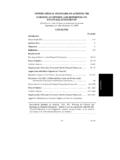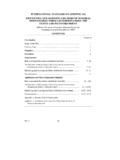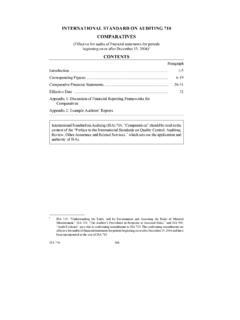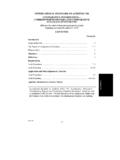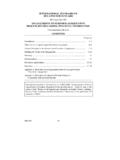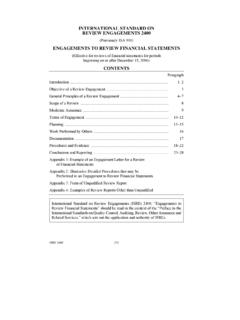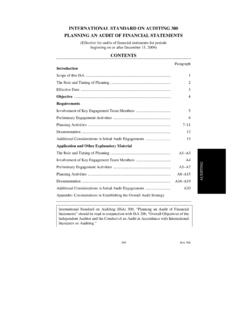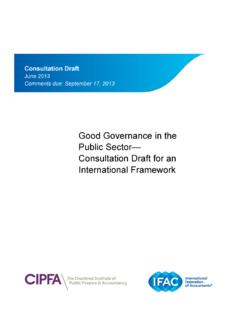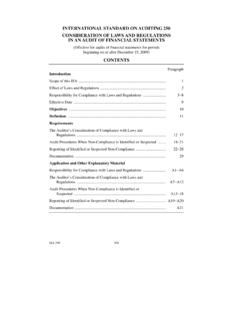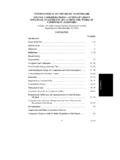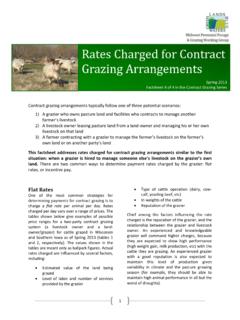Transcription of INTERNATIONAL STANDARD ON AUDITING 265 …
1 ISA 265 237 AUDITING INTERNATIONAL STANDARD ON AUDITING 265 communicating deficiencies IN internal CONTROL TO those charged WITH GOVERNANCE AND MANAGEMENT (Effective for audits of financial statements for periods beginning on or after December 15, 2009) CONTENTS Paragraph Introduction Scope of this ISA .. 1 3 Effective Date .. 4 Objective .. 5 Definitions .. 6 Requirements .. 7 11 Application and Other Explanatory Material Determination of Whether deficiencies in internal Control Have Been Identified .. A1 A4 Significant deficiencies in internal Control .. A5 A11 Communication of deficiencies in internal Control .. A12 A30 INTERNATIONAL STANDARD on AUDITING (ISA) 265, communicating deficiencies in internal Control to those charged with Governance and Management should be read in conjunction with ISA 200, Overall Objectives of the Independent Auditor and the Conduct of an Audit in Accordance with INTERNATIONAL Standards on AUDITING .
2 communicating deficiencies IN internal CONTROL TO those charged WITH GOVERNANCE AND MANAGEMENT ISA 265 238 Introduction Scope of this ISA 1. This INTERNATIONAL STANDARD on AUDITING (ISA) deals with the auditor s responsibility to communicate appropriately to those charged with governance and management deficiencies in internal control1 that the auditor has identified in an audit of financial statements. This ISA does not impose additional responsibilities on the auditor regarding obtaining an understanding of internal control and designing and performing tests of controls over and above the requirements of ISA 315 and ISA ISA 2603 establishes further requirements and provides guidance regarding the auditor s responsibility to communicate with those charged with governance in relation to the audit.
3 2. The auditor is required to obtain an understanding of internal control relevant to the audit when identifying and assessing the risks of material In making those risk assessments, the auditor considers internal control in order to design audit procedures that are appropriate in the circumstances, but not for the purpose of expressing an opinion on the effectiveness of internal control. The auditor may identify deficiencies in internal control not only during this risk assessment process but also at any other stage of the audit. This ISA specifies which identified deficiencies the auditor is required to communicate to those charged with governance and management. 3. Nothing in this ISA precludes the auditor from communicating to those charged with governance and management other internal control matters that the auditor has identified during the audit.
4 Effective Date 4. This ISA is effective for audits of financial statements for periods beginning on or after December 15, 2009. Objective 5. The objective of the auditor is to communicate appropriately to those charged with governance and management deficiencies in internal control that the auditor has identified during the audit and that, in the auditor s professional judgment, are of sufficient importance to merit their respective attentions. 1 ISA 315, Identifying and Assessing the Risks of Material Misstatement through Understanding the Entity and Its Environment, paragraphs 4 and 12. 2 ISA 330, The Auditor s Responses to Assessed Risks. 3 ISA 260, Communication with those charged with Governance. 4 ISA 315, paragraph 12. Paragraphs A60 A65 provide guidance on controls relevant to the audit.
5 communicating deficiencies IN internal CONTROL TO those charged WITH GOVERNANCE AND MANAGEMENT ISA 265 239 AUDITING Definitions 6. For purposes of the ISAs, the following terms have the meanings attributed below: (a) Deficiency in internal control This exists when: (i) A control is designed, implemented or operated in such a way that it is unable to prevent, or detect and correct, misstatements in the financial statements on a timely basis; or (ii) A control necessary to prevent, or detect and correct, misstatements in the financial statements on a timely basis is missing. (b) Significant deficiency in internal control A deficiency or combination of deficiencies in internal control that, in the auditor s professional judgment, is of sufficient importance to merit the attention of those charged with governance.
6 (Ref: Para. A5) Requirements 7. The auditor shall determine whether, on the basis of the audit work performed, the auditor has identified one or more deficiencies in internal control. (Ref: Para. A1 A4) 8. If the auditor has identified one or more deficiencies in internal control, the auditor shall determine, on the basis of the audit work performed, whether, individually or in combination, they constitute significant deficiencies . (Ref: Para. A5 A11) 9. The auditor shall communicate in writing significant deficiencies in internal control identified during the audit to those charged with governance on a timely basis. (Ref: Para. A12 A18, A27) 10. The auditor shall also communicate to management at an appropriate level of responsibility on a timely basis: (Ref: Para. A19, A27) (a) In writing, significant deficiencies in internal control that the auditor has communicated or intends to communicate to those charged with governance, unless it would be inappropriate to communicate directly to management in the circumstances; and (Ref: Para.)
7 A14, A20 A21) (b) Other deficiencies in internal control identified during the audit that have not been communicated to management by other parties and that, in the auditor s professional judgment, are of sufficient importance to merit management s attention. (Ref: Para. A22 A26) communicating deficiencies IN internal CONTROL TO those charged WITH GOVERNANCE AND MANAGEMENT ISA 265 24011. The auditor shall include in the written communication of significant deficiencies in internal control: (a) A description of the deficiencies and an explanation of their potential effects; and (Ref: Para. A28) (b) Sufficient information to enable those charged with governance and management to understand the context of the communication. In particular, the auditor shall explain that: (Ref: Para. A29 A30) (i) The purpose of the audit was for the auditor to express an opinion on the financial statements; (ii) The audit included consideration of internal control relevant to the preparation of the financial statements in order to design audit procedures that are appropriate in the circumstances, but not for the purpose of expressing an opinion on the effectiveness of internal control; and (iii) The matters being reported are limited to those deficiencies that the auditor has identified during the audit and that the auditor has concluded are of sufficient importance to merit being reported to those charged with governance.
8 ** Application and Other Explanatory Material Determination of Whether deficiencies in internal Control Have Been Identified (Ref: Para. 7) A1. In determining whether the auditor has identified one or more deficiencies in internal control, the auditor may discuss the relevant facts and circumstances of the auditor s findings with the appropriate level of management. This discussion provides an opportunity for the auditor to alert management on a timely basis to the existence of deficiencies of which management may not have been previously aware. The level of management with whom it is appropriate to discuss the findings is one that is familiar with the internal control area concerned and that has the authority to take remedial action on any identified deficiencies in internal control. In some circumstances, it may not be appropriate for the auditor to discuss the auditor s findings directly with management, for example, if the findings appear to call management s integrity or competence into question (see paragraph A20).
9 A2. In discussing the facts and circumstances of the auditor s findings with management, the auditor may obtain other relevant information for further consideration, such as: communicating deficiencies IN internal CONTROL TO those charged WITH GOVERNANCE AND MANAGEMENT ISA 265 241 AUDITING Management s understanding of the actual or suspected causes of the deficiencies . Exceptions arising from the deficiencies that management may have noted, for example, misstatements that were not prevented by the relevant information technology (IT) controls. A preliminary indication from management of its response to the findings. Considerations Specific to Smaller Entities A3. While the concepts underlying control activities in smaller entities are likely to be similar to those in larger entities, the formality with which they operate will vary.
10 Further, smaller entities may find that certain types of control activities are not necessary because of controls applied by management. For example, management s sole authority for granting credit to customers and approving significant purchases can provide effective control over important account balances and transactions, lessening or removing the need for more detailed control activities. A4. Also, smaller entities often have fewer employees which may limit the extent to which segregation of duties is practicable. However, in a small owner-managed entity, the owner-manager may be able to exercise more effective oversight than in a larger entity. This higher level of management oversight needs to be balanced against the greater potential for management override of controls. Significant deficiencies in internal Control (Ref: Para.)
